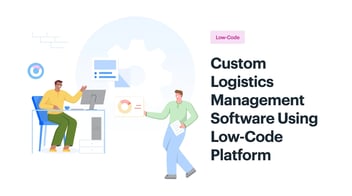
- >
- Low-Code Platform >
- Open source vs. licensed low-code platform: Which one should you use?
Open source vs. licensed low-code platform: Which one should you use?
As organizations increasingly seek digital solutions to streamline operations, low-code platforms have emerged as essential tools. These platforms enable faster, more flexible application development than traditional coding methods. However, choosing between an open-source, low-code platform and a licensed proprietary platform is a crucial decision that impacts security, productivity, and scalability. Here’s a closer look at the advantages and limitations of each approach and why licensed low-code platforms like Kissflow are often the better choice.
Understanding open-source low-code platforms
Open-source low-code platforms allow users to create applications with minimal coding while offering full access to the platform’s source code. This setup gives businesses the freedom to modify and customize applications as needed. For organizations with skilled developers, open-source low-code no-code platforms can be a cost-effective way to build custom applications tailored to unique needs.
However, despite these benefits, open-source platforms also bring challenges that can limit their suitability for enterprises. While they offer flexibility, they may require more maintenance, specialized skills, and heightened security measures, especially as organizations scale.
Why open-source low-code platforms may not be the best choice
While open-source low-code platform offer attractive customization and cost benefits, they also have notable drawbacks that make them less ideal for many organizations. Here’s why:
1. Increased security risks
Open-source platforms make their source code publicly available, exposing the platform to security risks. While beneficial for customization, this transparency also means malicious actors can exploit vulnerabilities more quickly. Licensed platforms, by contrast, offer rigorous security protocols, regular audits, and compliance certifications, helping organizations safeguard their data and meet regulatory requirements.
2. Lack of dedicated support
Unlike licensed platforms that offer dedicated support teams, open-source platforms rely heavily on community support. Although online forums can provide insights, they need more immediacy and reliability of professional customer service. When issues arise, organizations may face delays in finding solutions, impacting productivity and operational efficiency.
3. Limited integration capabilities
Open-source platforms can need help to integrate easily with enterprise systems, often requiring custom code or additional configuration to connect with existing business tools. Licensed platforms are designed with pre-built connectors and APIs, allowing easy integration with major systems like ERP and CRM tools. This feature is crucial for organizations that need streamlined workflows across various departments. See ready-made connectors in Top 15 enterprise tools you can integrate with Kissflow’s low-code platform
4. Higher long-term costs and maintenance
While open-source platforms may seem cost-effective initially, maintaining and customizing them results in hidden costs over time. Organizations must rely on niche technical expertise to customize open-source code, and they handle updates, bug fixes, and enhancements internally or through the community, which consumes time and resources.
5. Complexity and usability challenges
Open-source platforms are typically designed by and for developers, prioritizing functionality over ease of use. Non-technical users may need help navigating these platforms. Licensed platforms, in contrast, prioritize intuitive interfaces, empowering both IT and business users to create applications without extensive training. While open-source low-code platforms offer unmatched flexibility, it’s useful to explore how they differ from no-code tools in this detailed low-code vs no-code comparison.
Understanding licensed low-code platforms
Top low code platforms offer a complete development solution through a user-friendly, drag-and-drop interface, pre-built integrations, and robust support services. These platforms are crafted for security, scalability, and ease of use, enabling IT teams and non-technical users to collaborate to build applications that meet organizational requirements. Licensed low-code platforms provide a secure environment for application development, ensuring compliance with industry standards and reducing the need for extensive coding skills.
Learn more: Types of Low-Code Platforms
Benefits of using a licensed low-code platform
-
Rapid development and deployment: Licensed platforms are built for speed, featuring tools that support immediate deployment and allow businesses to bring applications to market faster. This rapid turnaround helps organizations respond swiftly to changing business needs.
-
Enhanced security and compliance: Licensed platforms implement strict security protocols and regular audits, ensuring that applications meet compliance requirements and protect sensitive data. This level of security is essential for industries with high-security demands, such as finance and healthcare.
-
Dedicated support and regular updates: Vendors of licensed platforms provide consistent support, troubleshooting, and updates, ensuring that the platform evolves with industry standards. This dedicated support minimizes downtime and ensures organizations have access to the latest features and improvements.
-
Easy integrations: Proprietary low-code platforms often include built-in integrations with significant software tools, enabling smoother interoperability with existing systems. This feature simplifies workflows and enhances productivity across departments.
-
Optimized for citizen development: Licensed platforms are designed to empower citizen developers and non-technical users who can create applications under IT oversight. This approach helps organizations reduce IT backlogs and encourages innovation across teams, all while maintaining control and governance.
While this page explores open-source options, this guide on Power Automate highlights a structured approach to low-code automation.
Learn more: What is Enterprise Application Modernization
Why licensed low-code is the way forward
While open-source platforms may appeal to developers seeking complete control, licensed low-code platforms are generally better suited to organizational needs. Licensed platforms provide a practical solution by balancing customization with security, support, and ease of use. Licensed low-code platforms offer a clear advantage for enterprises that prioritize scalability, reliable support, and rapid deployment.
Choosing a licensed low-code platform allows organizations to build secure, high-quality applications that align with business requirements without the risks and limitations associated with open-source software. With its intuitive tools, robust integrations, and focus on enterprise security, a licensed platform enables businesses to innovate efficiently and achieve digital transformation goals.
Choosing a licensed low-code platform: Kissflow as a solution
Kissflow is a prime example of a licensed low-code platform designed for today’s enterprise needs. Unlike open-source options, Kissflow provides a secure, flexible, and user-friendly environment optimized for rapid development and scalability. Here’s why enterprises are turning to Kissflow for their low-code needs:
-
All-in-one development toolkit: Kissflow offers a unified platform with everything needed to build, test, and deploy applications, from simple workflows to complex enterprise-grade applications. This complete toolkit streamlines the entire development process, reducing complexity.
-
Unlimited application potential: Kissflow allows businesses to build, modify, and scale applications across various use cases without being limited by open-source constraints. This flexibility supports organizational growth and adaptation to evolving business needs.
-
Easy integrations and customization: Kissflow integrates easily with popular business software, making connecting applications and streamlining operations simple. Additionally, it provides powerful customization options within a secure framework so users can tailor applications to unique requirements without compromising security.
-
Advanced security and compliance: Built with enterprise-level security, Kissflow offers robust compliance features, ensuring data protection and adherence to industry security standards.
-
Round-the-clock support and continuous updates: Kissflow provides dedicated support and frequent updates, ensuring the platform remains aligned with industry trends and offers the latest features. This support allows users to troubleshoot issues and maximize the platform’s potential.
By choosing Kissflow, organizations gain a dependable, cost-effective solution for building high-quality applications that meet their business demands. Explore how Kissflow can support your digital transformation goals and provide a secure, efficient platform for innovation. Get started with the Kissflow Platform and learn how to leverage its features to drive better results
Frequently Asked Questions
1. What are the benefits of open-source low-code platforms?
Benefits of open-source low-code platforms include lower total cost of ownership without licensing fees, greater flexibility to customize for specific needs, reduced vendor lock-in risks, stronger security through community oversight, faster adoption of emerging technologies, and the ability to integrate with a wider range of systems and services.
2. How do licensed low-code solutions compare?
Licensed low-code solutions typically offer more robust enterprise features, dedicated support, stronger security and compliance capabilities, pre-built industry-specific templates, and guaranteed service levels compared to open-source alternatives. However, they involve ongoing licensing costs, potential vendor lock-in, and may offer less flexibility for highly customized requirements.
3. What industries prefer open-source development?
Industries preferring open-source development include technology startups optimizing costs, educational institutions promoting knowledge sharing, research organizations requiring transparency and customization, mid-sized businesses seeking flexibility, and organizations with strong internal development capabilities that can support and extend open-source solutions.
4. What are the top low-code platforms in 2025?
Low code automation tools that help businesses streamline workflows include process mining platforms that automatically discover inefficiencies from system logs, workflow automation solutions for repetitive tasks, visual process designers for non-technical users, collaboration platforms reducing communication barriers, document management systems, analytics dashboards for performance monitoring, and AI-powered decision support systems.
5. How does AI enhance low-code development?
AI enhances low-code development by suggesting optimal components based on requirements, generating application logic from natural language descriptions, creating data models from imported samples, identifying potential issues before deployment, optimizing user interfaces for different devices, and continuously learning from development patterns to improve future suggestions.
6. Why do enterprises consider open-source low-code platforms for internal development?
Enterprises explore open-source low-code tools for flexibility, customization, and the ability to tailor components to specific needs. These platforms appeal to IT teams that prefer deeper control over code layers and deployment environments while still enabling faster application delivery.
7. What challenges do IT teams face when maintaining open-source low-code platforms?
Challenges include managing updates, ensuring security patches, handling integrations manually, and supporting custom extensions. Without vendor-managed infrastructure, IT must allocate resources for maintenance, monitoring, and long-term reliability.
8. How suitable are open-source low-code platforms for non-technical users?
Open-source low-code platforms often require more technical understanding than fully managed platforms. Business users may find them less intuitive, depending on the maturity of the UI and documentation. IT support is usually necessary for initial onboarding.
9. Can open-source low-code platforms scale for enterprise-wide automation?
Scaling is possible but requires a strong internal DevOps capability. IT teams must manage infrastructure, performance optimization, and security configurations. Enterprises with dedicated engineering resources are better positioned to scale open-source solutions.
10. What governance considerations apply to open-source low-code tools?
Governance includes managing custom code contributions, version control, role-based access, and consistent standards. Without built-in enterprise governance layers, organizations must define their own oversight structure.
11. How do enterprises evaluate whether open-source low-code is the right fit?
They assess internal technical capacity, need for customization, available DevOps support, and long-term maintenance readiness. Open-source is attractive when flexibility outweighs the convenience of vendor-managed environments.
Learn more about how you can transform your application needs.
Related Articles












